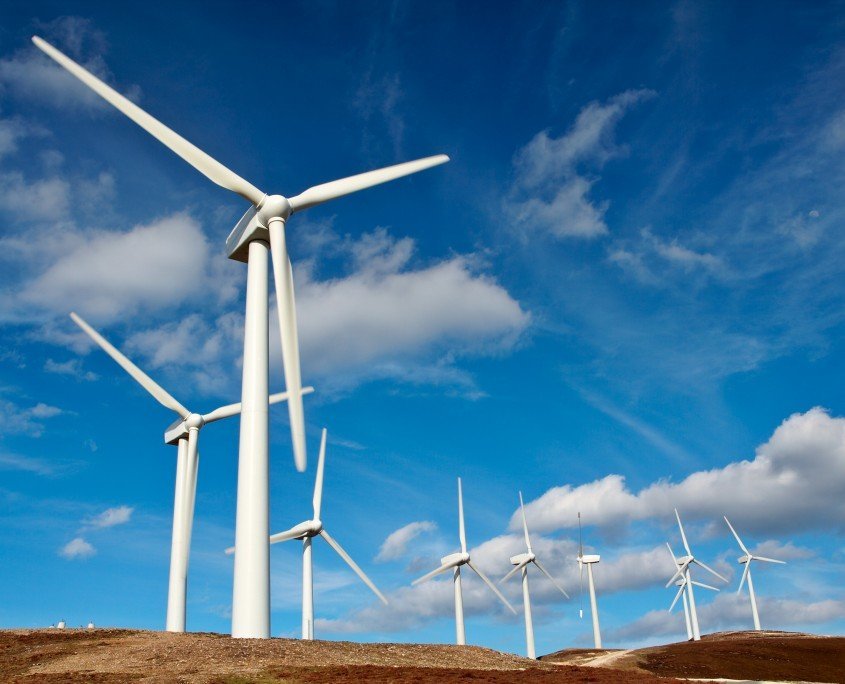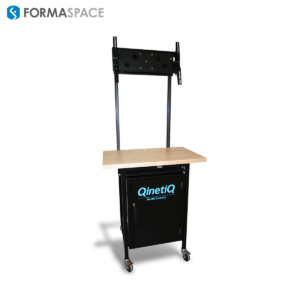Focus on Industrial Infrastructure
We continue with a discussion of some of the industrial infrastructure issues facing Formaspace customers. Today we take a look at renewable energy production — a topic of concern especially for our industrial consumers who use large amounts of energy, such as those engaged in heavy manufacturing or Internet service companies operating cloud data centers. Recently we’ve looked at how German investment in renewable energy has driven down the costs of solar panels. And we’ve also looked at how American renewable energy production compares with the European Union and more specifically with Germany. This week we take a look at some of the challenges that the renewable wind energy sector faces in acquiring offshore leases, securing funding and connecting to the existing conventional electrical grid.
US Electricity Production from Offshore Wind Farms is Just Beginning
When we made a comparison with European renewable energy production last week, we noted that biomass was the major difference between the two continents — European electricity production from renewable biomass is high, and it’s practically nil in the US. But there’s another difference that we did not have space to mention: nearly all German wind farms are located offshore in the windy North Sea region while all US wind farm energy production is located on land. But that is about to change.

News from Today’s AWEA Offshore Wind Power Conference in Atlantic City, NJ
The primary trade group representing the renewable wind energy sector is the American Wind Energy Association, known as a AWEA. It got even bigger last month when it was announced that the other wind lobbying group, the Offshore Wind Development Coalition (OWDC), would join forces with AWEA. Over the last two days, the AWEA has been conducting their Offshore Wind Power Conference in Atlantic City, New Jersey. It has featured notable guest speakers such as Collin O’Mara, the new President and Chief Executive Officer of the National Wildlife Federation.
Sally Jewell, the recently appointed Secretary of the U.S. Department of the Interior also spoke at the AWEA conference. In her role as Secretary of the Interior, Jewell has oversight over the Bureau of Ocean Energy Management (BOEM) and their Office of Renewable Energy Programs. During a question-and-answer session Jewell gave a clue as to the timing of an upcoming auction for a single offshore lease totaling more than 740,000 acres — located in Federal waters outside the 12 mile mark off the coast of Massachusetts. Jewell indicated this auction, the fourth of its kind by the Feds, will take place before the end 2014. It will also be the largest single auction to date by acreage. By making more leases available the federal government should be able to attract additional investment needed to develop these renewable energy resources.
Two Major East Coast Offshore Wind Energy Projects in Late Stages of Planning Development
Construction plans are well underway for the Block Island Wind Farm, a 30 MW plant located off the coast of Rhode Island. This project, undertaken by Deepwater Wind, already has power purchase agreement (PPA) contracts lined up to sell the electricity production over the coming 15 years. They have already issued contracts for long-lead time equipment, like turbines from Alstom. Construction should start in 2015. A much more ambitious project — at 468 MW it’s more than 10 times larger — is the Cape Wind project, planned for waters offshore from Cape Cod, Massachusetts. This project is estimated to cost around $2.5 billion to build out; to date, the developer has reportedly secured nearly 2/3 of the required funding. Construction is also anticipated to begin in 2015.

Debates Over PTC Tax Credit for Investment in Wind Energy
We should take a moment to mention one of the ways that the Federal Government has supported the development of renewable energy in recent years. Since 1992, when Congress approved the Production Tax Credit (or PTC), renewable energy producers have received a 2.2 cent Federal tax credit for every kilowatt hour of electricity they produced by wind resources. As with other issues facing Congress, such as the debt ceiling and “the Sequester”, there has been contentious debate about whether to continue renewing the PTC. Interestingly, the factions for and against the PTC don’t line up neatly along traditional Republican and Democratic party lines. Instead, Senators and Congressmen from many of the Western states where there are ample wind resources tend to be in favor of renewing the PTC, while those in other states without much in the way of wind resources are against.
Senate Majority Leader Harry Reid declared last month that he intends to push for extending the wind energy production tax credit and other similar initiatives supporting renewable energy production by the end of this year. But of course that’s no guarantee that it will come to pass, and the resulting uncertainty is playing havoc for those trying to seek the enormous financing required to construct these large wind farms as well as for those seeking to sell long-term term power purchase agreements with electrical utilities.
How Do You Transmit Electricity from These Offshore Wind Farms? Doesn’t That Make Locating these Projects in Offshore Waters Impractical and Costly?
As we all know electricity and water don’t mix, so it’s logical to assume that it would be really difficult and expensive to transfer the power from an offshore wind turbine to the electrical grid onshore. Rest assured, this is actually a solvable problem. Undersea enclose cables can safely transmit the power from offshore to onshore. What might surprise you is that the cost of building transmission lines for these East Coast-based offshore projects can be cheaper than building transmission lines to wind farm projects out in Western states.
How Can That Be?
As it turns out, a critical cost issue is the distance of a proposed wind farm project from a suitable interconnection point on the existing electrical grid. And since current offshore wind farm leases along the Eastern Seaboard are relatively close to urban areas — with significant electrical grid infrastructure conveniently located nearby — constructing offshore transmission lines can end up being cheaper to build compared to those needed for onshore wind farms. That’s because the best locations for wind farm energy production in the Western states tend to be in rural areas far from major electrical grid interconnections, sometimes many hundreds of miles away.
Warren Buffett’s Investment in Transmission Lines
One of the very large energy companies in the Western US is PacifiCorp. (You may recall that Warren Buffett’s Berkshire Hathaway purchased PacifiCorp for a cool $5.1 billion in cash back in 2005.) PacifiCorp’s three main subsidiaries, Pacific Power, Rocky Mount Power and PacifiCorp Energy are addressing the need to expand their transmission grid by undertaking three parallel construction projects — known as Gateway West, Gateway Central and Gateway South. The first sections of this massive EnergyGateway Project went into service in 2010, but it’s expected to take up until 2023 before the entire system is online. In the illustration below (courtesy of PacifiCorp), you can see the scope of the project — it covers the western third of the U.S.

The next map shows the EnergyGateway transmission lines in development superimposed over data from the National Renewable Energy Laboratory that highlights areas with the greatest wind power potential.

The blue and red areas have the highest wind energy potential, and — aside from some sites in the Rocky Mountains west of Denver — the best potential sites for wind farms are located far from core urban areas and existing high-power transmission lines.
Texas Stays Independent
Texas has tried hard to keep its electrical grid system — known as the Texas Interconnection — separate from the rest of the nation. This home-grown electrical grid — which covers nearly all of Texas except for the upper panhandle and the eastern border with Louisiana — is also sometimes referred to as the “ERCOT” grid — a name taken from the state’s power grid regulatory agency — the Electric Reliability Council of Texas — which came into being in 1970. In 2008, the Texas Public Utility Commission established seven Competitive Renewable Energy Zones, known by the acronym CREZ. The idea was to establish a way to finance construction of new lines to connect the growing solar wind farm energy production in the western part of the state with Texas’ biggest cities, like the Dallas / Fort Worth metroplex.

This past March, Austin-based Lone Star Transmission turned on the switch and energized all 330 miles of their newly completed transmission lines — designed to bring renewable energy from the western part of the state to the major population centers in central and northern Texas. Construction took around three years and employed 900 workers. Over 2,500 spun concrete monopoles were erected along on the route from Scurry County, northwest of Abilene to Navarro County just south of Dallas.
“To enhance the reliability of the Electric Reliability Council of Texas (ERCOT) transmission grid and help ensure customers have access to affordable power, transmission lines like the ones we have just energized are critical to Texas’ energy future,” said Lone Star Transmission President Mike Grable. “This project, delivered on-time and under budget, will benefit Texans for decades to come. We look forward to exploring new opportunities that will further strengthen the transmission grid and grow the Texas economy.”
At Formaspace We Believe in American Energy

Whether you are an energy producer, manufacturer, researcher, educator or professional, Formaspace technical furniture can bring new energy to your workplace. All Formaspace technical furniture is American-made, constructed right here at our factory headquarters in Austin, Texas. Join the roster of satisfied Formaspace technical, manufacturing and laboratory furniture clients — including Apple Computer, Boeing, Dell, Eli Lilly, Exxon Mobile, Ford, General Electric, Intel, Lockheed Martin, Medtronic, NASA, Novartis, Stanford University, Toyota and more.
Give us a call today at 800.251.1505 to find out more about the Formaspace line of stock, semi-custom and custom-made computer workstations, industrial workbenches, laboratory furniture, lab benches and dry lab/wet labs — as well as our design / furniture consulting services. We are so confident in what we build for you we back it up with our 12 year, 3 work shift furniture warranty– the best guarantee you’ll find in the industry.








